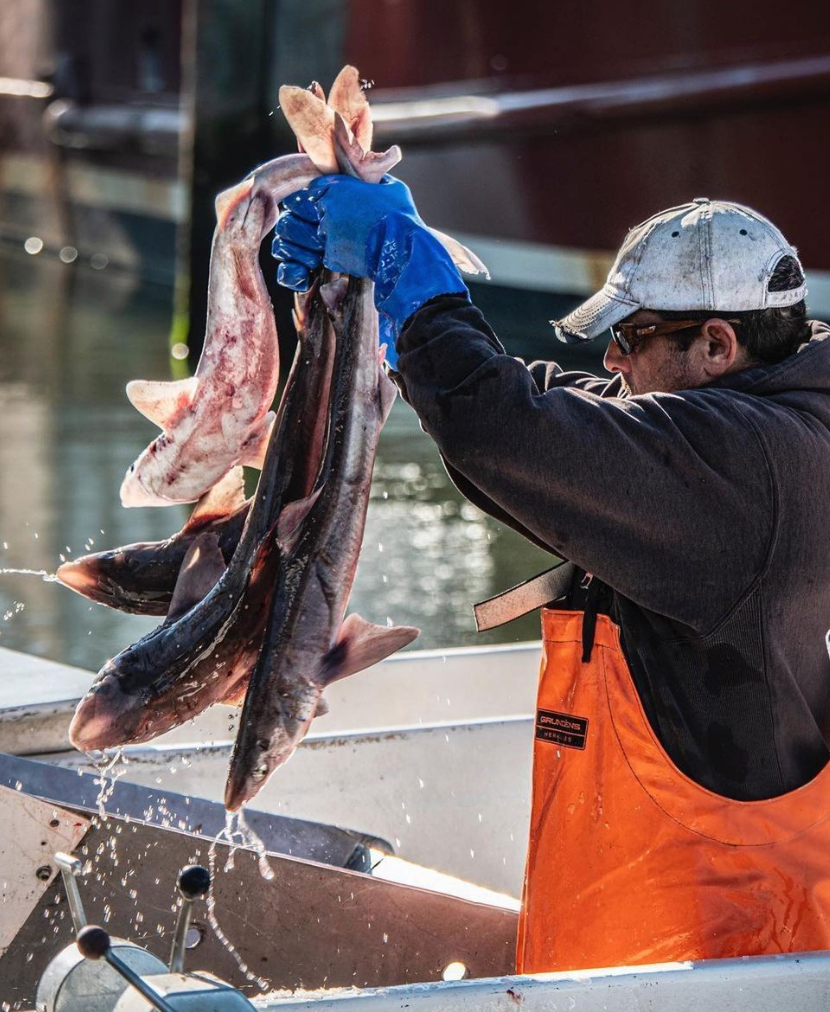
Dogfish
About dogfish
Dogfish (Squalus acanthias)—a.k.a. Houndfish, Mud Shark, or Cape Shark—are a type of small shark named for their habit of hunting in packs. Though consumers can be hesitant to try shark, dogfish is not to be dismissed! Historically, fishermen have considered dogfish a scourge, since the sharks prey voraciously on other valuable fish and are capable of ripping fishing nets. They are sometimes caught incidentally (as bycatch), though dogfish is increasingly being intentionally sought after. Much of the dogfish caught in local waters is sent to Europe. It is popular in the United Kingdom, where it’s one of the traditional fish used in fish and chips. Viking Village sends most of its smooth dogfish to Australia, where there’s a big market for them.
Storage and Cleaning
-
Keep the dogfish refrigerated at 40°F or lower until you are ready to use it. We recommend using your fish within 2-3 days. If you know you won’t be able to use it by then, the sooner you freeze it, the better. Leftover cooked fish can be stored for up to 4 days.
-
To freeze, pat the fish dry. Wrap fillet(s) with a couple layers of plastic wrap or foil. Place fillet(s) into a freezer bag or airtight container. If using a freezer bag, press out any excess air and seal as tight as possible. Try not to put more than one pound of fillets in each bag. This will allow the fish to freeze more quickly. You can freeze for 3-6 months.
Cooking
- If there is an odor of ammonia, we recommend soaking your fillets in milk or water that has been acidified with vinegar or lemon juice. Typical soaking time is four hours or more. This can remove any taste of ammonia. Freezing the dogfish for two weeks also extracts the ammonia taste.
-
It has white meat that’s buttery when cooked, naturally boneless, and mild in flavor when prepared properly. Barton Seaver, author of “American Seafood” describes the taste of dogfish as “a better version of halibut” and “akin to a cross between the chewy flake of cod and the richer, fattier salmon.” It maintains its moisture well when cooked. It’s also a great candidate for smoking, and performs well in chowders or stews (see recipe below). It can be used interchangeably with other mild fish, such as flounder or halibut.
If you want to learn more, here is an NPR story on eating dogfish.
More on dogfish
Appearance? The Spiny Dogfish has two distinguishing features: rows of small white dots that run along its sides, and a sharp spine that is found in front of each of its two dorsal fins. The spines of the Spiny Dogfish are formed from material much like that of our teeth. Other distinguishing features include the lack of an anal fin, and the rounded, un-notched tail, unlike the Smooth Dogfish. In the water, the white spots are the thing most likely to jump out at you for identification, although they fade away in some older individuals.
Where? Spiny dogfish are found in the North Atlantic and North Pacific Oceans, mostly in the temperate and subarctic areas. In the Northwest Atlantic, they are found from Labrador to Florida and are most abundant between Nova Scotia and Cape Hatteras. Dogfish are thought to be the world’s most abundant shark, occurring worldwide in temperate and sub-arctic ocean waters.
They prefer cooler water temperatures, from a low of around 45-46 F to a high of 54-59 F, and occur in oceans and coastal zones but rarely enter the upper reaches of estuaries and never occur in freshwater. Spiny Dogfish are gregarious in nature, often occurring in ‘packs’ of hundreds or even thousands of individuals, and may be found anywhere in the water column, from the bottom to the surface.
Sources: Viking Village, Chef’s Resources, NOAA
Photo: @vikingvillagelbi, Viking Village fishermen pack freshly caught dogfish
Last updated: 1/3/2023